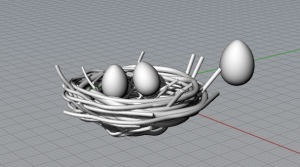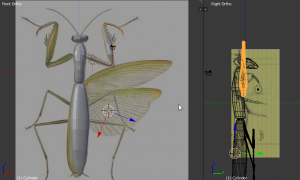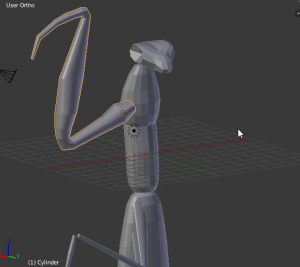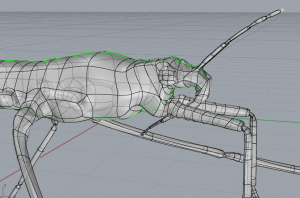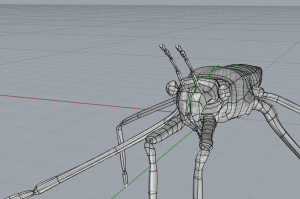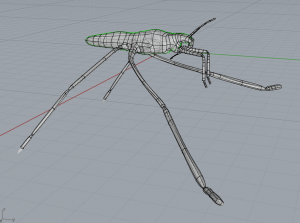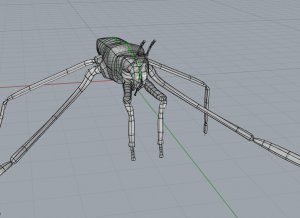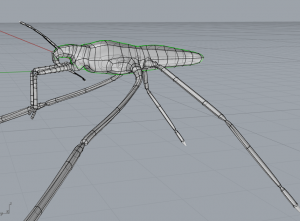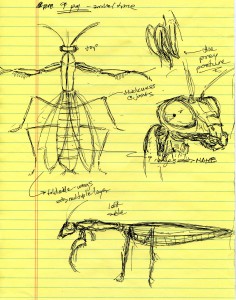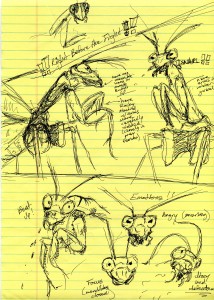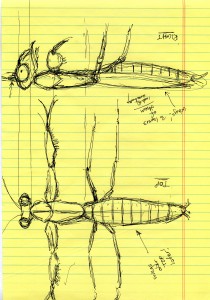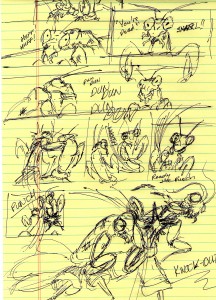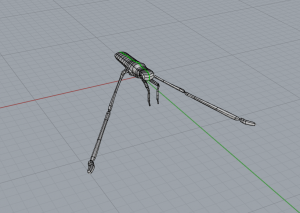Month: April 2013
Intermediate 130405
Diefenderfer: More Test Renders and Progress
I added some fire-like camouflage to keyshot to use it as a color map to give a more realistic coloring than only coloring the broken-up surfaces, which yielded straight lines. The camo is not as high a resolution as I would have liked, but this is only a test render of the (mostly) completed Wasp
splitting surfaces up for Keyshot
How did you split apart the T-splines surfaces for your pelican for keyshot? Converting the surface to NURBS and exploding does not seem like the best move for this.
– – –
Hi Phil,
There are many different approaches that can work for splitting surfaces up, but I found a couple of methods to be particularly effective when I prepared my pelican model for keyshot:
1) If you want to split the surface in a way that works with your existing isocurves then you can run the “split by isocurve” command. On your left main Rhino menu you should be able to right click on the “split” button to initiate the “split by isocurve” command. You’ll then be able to drag the split boundary where you want it — note that you can toggle the U and V orientation.
2) If you want to split the surface in way that does not work with your existing isocurves then you’ll need to create curves on the surface of your model and use them to split it apart. To do this you can project curves to the surface, or you might also try interpolating curves on the surface (I had really good luck with this method around the pelican’s eyes and beak). I believe you can find this command in the left main Rhino menu– look under in the submenu associated with control point curves.
Please let me know if these methods help you achieve the result you’re looking for.
take care,
Prof. Meiser
Intermediate 130404
Intermediate 130403
Progress #1: Vertex Stitching is a Pain
So far, after drawing out carefully what the feel and look of my final design would be, I have taken my time keeping my model low resolution and worrying more about the form itself, as well as proportion. With a good underlying, low-res geometric form, sculpting in the higher resolution details will be more effective.
I made an alternative design decision that instead of modeling the mantis as separate components that I would rig for posing, I will instead model a continuous form since rigging the model with bones will deform the mesh in a cleaner, more realistic fashion than using ball-joints that I would mold to the pose like I originally thought I would do. Hence the title of this post. I’ve been vertex stitching my disparate pieces so I can create a continuous form….it may not look like much now, but experience has shown me that attention paid to the low-res form in the beginning will lead to effective rigging. Bones that deform a mesh use areas of influence to pull vertices around, given user-set tolerances, or “weights.” However, bones can, when pulled in certain ways during the posing stage can lead to very odd deformations if the underlying mesh isn’t correct, so I’m being very careful so I save myself a great deal of agony later when it will be a bad idea to edit the mesh once it is rigged….
Note that the raptorial legs and back legs are not in their final rest pose. I will flatten them out once vertex stitching is done.
More Sculpting in the Lab…
More Sculpting in the lab…
Intermediate 130402
Screenshot of Wings from the weekend
Pretty proud of how they look…
Some Sketches of Potential Scenes
The sketches below show the arrival of cortes on a piece of driftwood, the tlaxcalan (army ant) bowing to cortes, a swarm scene with a rusted rapier sword against a rock, a potential form of Cortes, a destroyed Aztec pyramid with thousands of bug carcasses after the battle:
Narrative Research
I intend to recreate the legend of Spanish Conquistador Hernan Cortes, specifically the siege of Tenochtitlan. Although the siege historically happened, many of the events have been dramatized and exaggerated in the legend, lending larger than life characteristics on the major characters. The story goes that Cortes arrives to the Yucatan Peninsula of Mexico in search of gold and power with a relatively small group of Conquistadors, who posses weapons, immunity to disease, armor, and mobility (horses) that are superior to that of the technology of the native Aztecs and other nations. Cortes’ force is much too small to take over the Aztec’s alone. Rather than rely on brute force he takes advantage of a native prophecy that causes Aztecs and others to believe he is a power feathered serpent god Quetzalcoatl. Using this belief, Cortes tricks some of the natives, the Tlaxcalans, into allying with him. Cortes leads his small army and the enormous army of the Tlaxcalans to destroy the longstanding city of Tenochtitlan and soon the Aztec civilization with a brutal siege, destroying lives, crops and homes of thousands.
I chose this story because I think that the Conquistadors share many traits with the invasive, yet subtle stink bug.
Turning points:
1. Cortes arrival to Mexico and establishment with local allies using his god-persona.
2. The actual siege of Tenochtitlan, a scene of swarming, destruction, and senseless violence.
3. The aftermath of the battle, in which the once great city is destroyed and many members of all parties involved are dead. This scene is the start of centuries of corruption/an important removal of freedom in Mexico.
I intend to emphasize many parts of the story that are now considered to be historically inaccurate, such as the notion that the Tlaxcalans betrayed fellow natives and the idea that Cortes was actually believed to be a god. I intend to change these because I think that these actions lend well to the sneaky qualities of the stink bug and I also believe that they better show the brutality of Spanish conquest, which was very real.
4.0 sketch
Step #4: Some Sketching
Narrative Research…Loch Ness Monster
I chose the myths and legends surrounding the Loch Ness Monster. Sometimes referred to as Nessie, this amphibious creature is said to live in the Scottish Highlands, specifically Loch Ness. It was first reported in 1933, by a couple named the Spicers. They saw the creature cross the road in front of their car when they were driving by the Loch. Since then, there have been many sightings that range in description of the beast. There have also been a few pictures and videos captured and expeditions organized to search for it. However, this modern-day dinosaur has eluded humans for generations.
I chose this story because I wanted the water strider to leave the traditional environment of the surface of lakes and streams. I wanted to the Loch Ness Monster to take him on an adventure and help him see he rest of the world. The monster can be dangerous to insects due to its size and the risk of accidental squashing, but otherwise he is a gentle giant that just wants to be left alone. This water strider, however, was lucky enough to get picked up and take a ride on the gentle giant.
In the story, the first moment of suspense comes as the Loch Ness monster creeps up behind the insect. By the ominous shadow under the water, one would believe the water strider is about to meet its end. But instead, his little hairy legs grab onto the scaly surface of the monster’s back and he a comes on the journey, enjoying the view of land from such a high vantage point. Finally, the water strider jumps down, landing in the puddle in the foot print of Nessie, and creates a home in this new exciting environment.
Obviously, I am taking creative license with the details of the story since there is no water strider mentioned in the eyewitness accounts of the Loch Ness Monster. But otherwise, I am sticking with the legends that claim it is a long animal that lives in both water and land.
Step 4: Concept Drawings
Step #2 – The Narrative
Target Clip: https://www.youtube.com/watch?v=es1OJfSDthI
I chose to examine the final battle between Rocky Balboa and Drago (the Russian antagonist boxer) in “Rocky IV” (1985). I’ve always enjoyed the constructed boxing matches in the more heroic setting (my father, brother, and I would watch these kinds of movies), and especially the Rocky movies’ tendency to have the boxing protagonist, Rocky, take a tremendous beating (sometimes not even protecting or guarding himself properly as a good fighter would) and then deliver the final knockout blow (or blows) to ultimately win the match. As a Martial Artist myself, I was also drawn to the recreation of a fight scene, and even though this is in the context of the sport of boxing, it made me think of the Randori matches characteristic of the practices I went to (of course, those were never as intense as a Rocky match, and keeping up one’s guard was much more important). The key moments in the clip are when Rocky finally delivers a few good blows to Drago after all seemed lost all too soon (this also shows that Rocky does stand a chance against this mighty opponent and this will prove to be a good fight) and when Rocky delivers the final critical blows to Drago, as triumphant music plays and the key secondary characters and the audience cheer, leading to the mighty Russian warrior’s collapse and the protagonist’s incredible victory. The primary thing that I intend to change about this story is the character species: instead of recreating this final climactic scene where Rocky turns the tide of battle and secures victory wholesale, I shall have the boxers be Praying Mantids (in boxer shorts–4 legged ones) instead of human beings. I feel that Praying Mantids would not only be a unique re-interpretation of this iconic movie scene, but appropriate in the sense that these hunting insects brutally attack their prey with their raptorial legs, which not only rest in a “praying position” (which has given the insect its nickname), but what I feel to be a “put ’em up” boxing style, defensive guard-like position.
Step 4- Sketches
Collect Visual References (Final Gallery)
These are images surrounding the water strider, the loch ness monster, shadows/monsters in the water, and ripples for my project.
Step 2- Narrative Research
I chose to use the story of Moses from the Old Testament. I will be highlighting different parts of Moses’ life that all are related directly to water. The reason why I chose this story is because there are many moments in his life and significant references related to water, and all dragonflies spend most of their time and live near water because in their larval stage, they are actually in a body of water. The major points during Moses’ life relating to water that would make for a good turning point in a film or a book are when he is found in a basket floating through the Nile and Bithya, Pharoah’s daughter finds him, when he parts the red sea, and when Moses struck a rock with a stick after the Israelites were thirsty, producing water.
In order to accommodate my insect, the dragonfly, I will create the dragonfly as a representation of god as a guardian and a guide throughout his life. In the Nile the dragonfly will be either in the water or flying by the reeds or on top of the basket with Moses in it. At the Red Sea, it will be a side view as if looking across the water with the dragonfly flying through with or near Moses and in the final scene, he will appear by the staff on the rock where there is a crack in it with water beginning to flow out.


















































